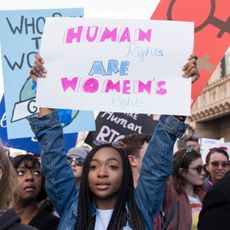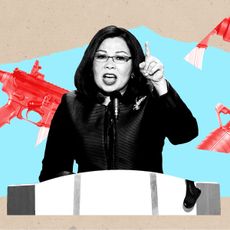The recent murder of abortion doctor George Tiller has raised the stakes on one of the hardest issues any of us will ever face. Two women tell their stories.
On May 31, Dr. George Tiller, one of the last remaining providers of third-trimester abortions, was gunned down in the lobby of his Wichita, KS, church by a deranged abortion foe. While the pro-life movement condemned the murder, it has spent years trying to outlaw the kind of services he provided. Pro-choice advocates argue that late-term abortions are necessary to protect the health of the mother and that she should have full control of these decisions; they also claim efforts to ban specific practices are the first step toward outlawing abortion altogether. How did late-term termination become the third rail in the abortion debate?
2003 President Bush signs into law Congress's Partial Birth Abortion Act, banning a procedure called "intact dilation and extraction," which involves puncturing the fetus's skull so it can pass through the cervix when removed.
2007 The Supreme Court upholds the law, the first time the court has ever permitted a ban on a specific abortion procedure that doesn't include an exception for the mother's health.
2009 In March, a Kansas jury acquits Dr. Tiller of carrying out 19 illegal late-term abortions. (Prosecutors had accused Tiller of violating Kansas law by failing to get a second opinion by an independent doctor.) On May 31, Tiller was shot and killed in his Wichita church. Today, there are only two late-term abortion clinics left in the country.
Stay In The Know
Marie Claire email subscribers get intel on fashion and beauty trends, hot-off-the-press celebrity news, and more. Sign up here.
-
 Charli D'Amelio Says Kim Kardashian "Inspired" Her to Work on Prison Reform
Charli D'Amelio Says Kim Kardashian "Inspired" Her to Work on Prison ReformThe social media star has partnered with REFORM Alliance.
By Iris Goldsztajn Published
-
 Henry Cavill and His Girlfriend Natalie Viscuso Are Expecting Their First Child
Henry Cavill and His Girlfriend Natalie Viscuso Are Expecting Their First ChildCongratulations are in order!
By Iris Goldsztajn Published
-
 Katy Perry's Top Almost Came All the Way Off on 'American Idol'
Katy Perry's Top Almost Came All the Way Off on 'American Idol'LOL.
By Iris Goldsztajn Published
-
 36 Ways Women Still Aren't Equal to Men
36 Ways Women Still Aren't Equal to MenIt's just one of the many ways women still aren't equal to men.
By Brooke Knappenberger Last updated
-
 What's at Stake in the 2022 Midterm Elections
What's at Stake in the 2022 Midterm ElectionsWith abortion rights, democracy, and many more critical issues on the ballot, there’s no room for apathy this election cycle.
By Rachel Epstein Published
-
 The 2022 Midterm Elections: What to Know Ahead of Election Day
The 2022 Midterm Elections: What to Know Ahead of Election DayConsider this your guide to key races, important dates, and more.
By Rachel Epstein Published
-
 4 Ways Your Rights Are on the Ballot This Election
4 Ways Your Rights Are on the Ballot This ElectionAccording to Vice President Kamala Harris.
By Emily Tisch Sussman Published
-
 Moms Will Make the Difference in the Midterm Elections
Moms Will Make the Difference in the Midterm ElectionsA plethora of issues impacting women and children will be top of mind for moms as they head to the polls this November.
By Emily Tisch Sussman Last updated
-
 How New York's First Female Governor Plans to Fight for Women If Reelected
How New York's First Female Governor Plans to Fight for Women If ReelectedKathy Hochul twice came to power because men resigned amid sexual harassment scandals. Here, how she's leading differently.
By Emily Tisch Sussman Last updated
-
 Why the 2022 Midterm Elections Are So Critical
Why the 2022 Midterm Elections Are So CriticalAs we blaze through a highly charged midterm election season, Swing Left Executive Director Yasmin Radjy highlights rising stars who are fighting for women’s rights.
By Tanya Benedicto Klich Published
-
 Tammy Duckworth: 'I’m Mad as Hell' About the Lack of Federal Action on Gun Safety
Tammy Duckworth: 'I’m Mad as Hell' About the Lack of Federal Action on Gun SafetyThe Illinois Senator won't let the memory of the Highland Park shooting just fade away.
By Sen. Tammy Duckworth Published